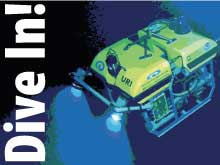
These lesson plans focus on the 2004 cruise to the Mariana Arc called "Exploring the Submarine Ring of Fire."
Education Lesson Plans
The Ring of Fire is an arc of active volcanoes and earthquake sites that partially encircles the Pacific Ocean Basin. The location of the Ring of Fire coincides with the location of oceanic trenches and volcanic island arcs that result from the motion of the large tectonic plates that make up the outer shell of the Earth (the lithosphere). These plates consist of a crust about 5 km thick, and comprise the upper 60 to 75 km of the Earth’s mantle.
The plates that make up the lithosphere move on a hot flowing mantle layer called the asthenosphere, which is several hundred kilometers thick. Heat within the asthenosphere creates convection currents (similar to the currents that can be seen if food coloring is added to a heated container of water). These convection currents cause the tectonic plates to move several centimeters per year relative to each other. Where tectonic plates slide horizontally past each other, the boundary between the plates is known as a transform plate boundary. As the plates rub against each other, huge stresses can cause portions of the rock to break, resulting in earthquakes. Places where these breaks occur are called faults. A well known example of a transform plate boundary is the San Andreas Fault in California.
Educators and scientists working with NOAA during March 2004 developed a series of lesson plans for students in Grades 5–12 that are specifically tied to the 2004 Submarine Ring of Fire expedition to the Mariana Arc. These lesson plans focus on cutting-edge ocean exploration and research using state-of-the-art technologies. Lessons address chemotrophic organisms, the effects of pollution on diversity in benthic communities, the energy content of hydrocarbon substrates in chemosynthesis, niches in coral reef ecosystems, reproduction in Cnidaria coral, characteristics of biological communities on deep-water reef habitats, DNA analysis, the energy content of hydrocarbon substrates in chemosynthesis, and growth-rate estimates based on isotope ratios.
The lesson plans are grouped into the following categories:
Grades 5-6
Grades 7-8
Grades 9-12
Each grade-level grouping includes activities that focus on the exploration and research being conducted as part of this expedition. In addition to being tied to the National Science Education Standards, the hands-on, inquiry-based activities include focus questions, background information for teachers, links to interesting Internet sites, and extensions. Web logs that document the latest discoveries and complement the lesson plans, complete with compelling images and video, will be regularly sent back from sea. Teachers are encouraged to use the daily logs posted on this site to supplement the lesson plans.
Read a description of each lesson plan and/or download them to your computer. All of the lesson plans are available in pdf format, and may be viewed and printed with the free Adobe Acrobat Reader ![]() . To download a lesson plan, click on its title from the listing below.
. To download a lesson plan, click on its title from the listing below.
Grades 5-6
The Volcano Factory (5 pages, 384k)
Focus: Volcanism on the Mariana Arc (Earth Science)
Students will be able to explain the tectonic processes that result in the formation of the Mariana Arc and the Mariana Trench.
Students will be able to explain why the Mariana Arc is one of the most volcanically active regions on Earth.
Grades 7-8
Friendly Volcanos (5 pages, 380k)
Focus: Ecological impacts of volcanism in the Mariana Islands (Life Science/Earth Science)
Students will be able to describe at least three beneficial impacts of volcanic activity on marine ecosystems.
Students will be able to explain the overall tectonic processes that cause volcanic activity along the Mariana Arc.
Grades 9-12
Hydrothermal Vent Challenge (7 pages, 412k)
Focus: Chemistry of hydrothermal vents (Chemistry)
Students will be able to define hydrothermal vents and explain the overall processes that lead to their formation.
Students will be able to explain the origin of mineral-rich fluids associated with hydrothermal vents.
Students will be able to explain how “black smokers” and “white smokers” are formed.
Students will be able to hypothesize how properties of hydrothermal fluids might be used to locate undiscovered hydrothermal vents.
For More Information
Contact Paula Keener-Chavis, national education coordinator for the NOAA Office of Ocean Exploration, for more information.
Other lesson plans developed for this Web site are available in the Education Section.



























